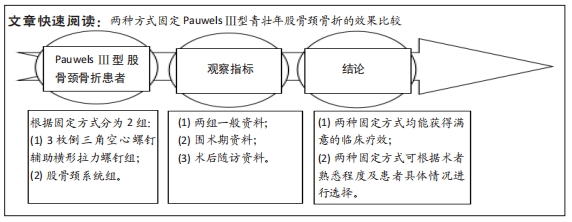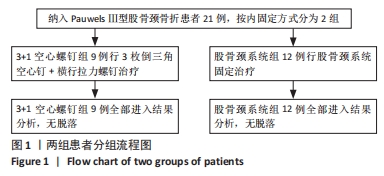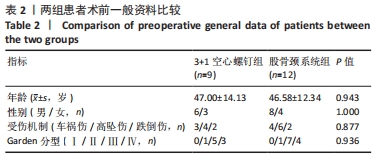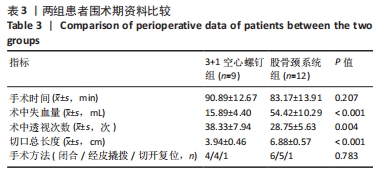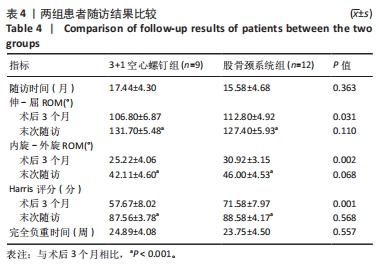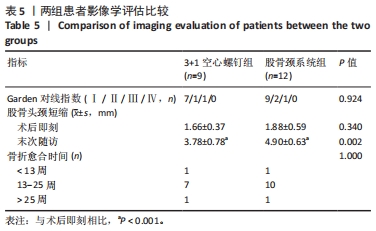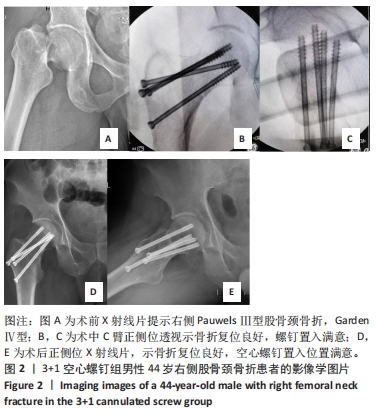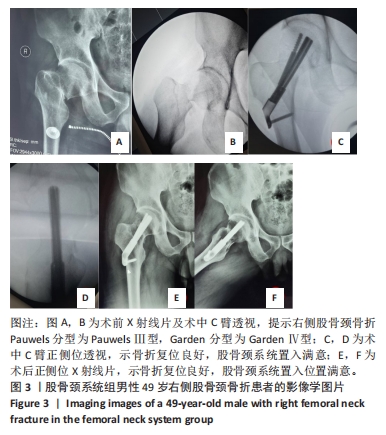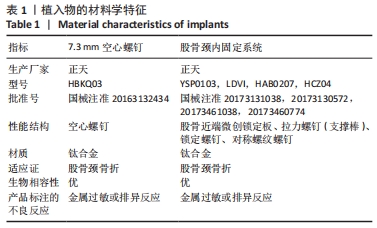[1] 柏秋实,张保中,常晓. PauwelsⅢ型股骨颈骨折内固定治疗的研究进展[J]. 中华骨与关节外科杂志,2021,14(5):437-441.
[2] 中华医学会骨科学分会创伤骨科学组,中国医师协会骨科医师分会创伤专家工作委员会. 成人股骨颈骨折诊治指南[J]. 中华创伤骨科杂志,2018,20(11):921-928.
[3] BARTONÍCEK J. Pauwels’ classification of femoral neck fractures: correct interpretation of the original. J Orthop Trauma. 2001;15(5): 358-560.
[4] 相庚,冯亚非,程建刚,等. 单头与双头螺纹空心钉固定治疗Pauwels Ⅲ型股骨颈骨折的生物力学性能比较[J]. 中华创伤骨科杂志,2019,21(12):1064-1068.
[5] GÜMÜŞTAŞ SA, TOSUN HB, AĞIR İ, et al. Influence of number and orientation of screws on stability in the internal fixation of unstable femoral neck fractures. Acta Orthop Traumatol Turc. 2014;48(6): 673-678.
[6] 段强民,李光磊,张冰,等. 4枚与3枚空心钉固定Pauwels Ⅲ型股骨颈骨折比较[J]. 中国矫形外科杂志,2022,30(2):113-118.
[7] 杨家赵,周雪锋,李黎,等. 股骨颈动力交叉钉系统和倒三角空心钉治疗Pauwels Ⅲ型股骨颈骨折疗效比较[J]. 中国修复重建外科杂志,2021,35(9):1111-1118.
[8] LEADBETTER GW. A treatment for fracture of the neck of the femur. Reprinted from J Bone Joint Surg 20:108-113, 1938. Clin Orthop Relat Res. 2002;(399):4-8.
[9] KUBIAK EN, BEEBE MJ, NORTH K, et al. Early weight bearing after lower extremity fractures in adults. J Am Acad Orthop Surg. 2013;21(12): 727-738.
[10] 中华医学会骨科学分会创伤骨科学组,中华医学会骨科学分会外固定与肢体重建学组. 中国下肢骨折术后负重专家共识(2023)[J]. 中华创伤骨科杂志,2023,25(2):93-100.
[11] BORAIAH S, PAUL O, HAMMOUD S, et al. Predictable healing of femoral neck fractures treated with intraoperative compression and length-stable implants. J Trauma. 2010;69(1):142-147.
[12] 党修亭,郑峰.Pauwels Ⅱ、Ⅲ型股骨颈骨折的内固定治疗进展[J].中国微创外科杂志,2022,28(11):909-913.
[13] 吴乾,袁振,郝跃峰,等.按骨折线倾斜角分型Ⅲ型青壮年股骨颈骨折的治疗进展[J].中华关节外科杂志(电子版),2018,12(6):791-795.
[14] WANG SH, YANG JJ, SHEN HC, et al. Using a modified Pauwels method to predict the outcome of femoral neck fracture in relatively young patients. Injury. 2015;46(10):1969-1974.
[15] KNOBE M, ALTGASSEN S, MAIER KJ, et al. Screw-blade fixation systems in Pauwels three femoral neck fractures: a biomechanical evaluation. Int Orthop. 2018;42(2):409-418.
[16] SLOBOGEAN GP, SPRAGUE SA, SCOTT T, et al. Complications following young femoral neck fractures. Injury. 2015;46(3):484-491.
[17] HUANG TW, HSU WH, PENG KT, et al. Effect of integrity of the posterior cortex in displaced femoral neck fractures on outcome after surgical fixation in young adults. Injury. 2011;42(2):217-222.
[18] ENOCSON A, LAPIDUS LJ. The vertical hip fracture - a treatment challenge. A cohort study with an up to 9 year follow-up of 137 consecutive hips treated with sliding hip screw and antirotation screw. BMC Musculoskelet Disord. 2012;13:171.
[19] SLOBOGEAN GP, SPRAGUE SA, SCOTT T, et al. Management of young femoral neck fractures: is there a consensus? Injury. 2015;46(3):435-440.
[20] 魏文卿,崔海坡,陈舰,等.不同固定方式对股骨颈骨折固定效果的影响[J].医用生物力学,2020,35(2):216-222.
[21] FILIPOV O. Biplane double-supported screw fixation (F-technique): a method of screw fixation at osteoporotic fractures of the femoral neck. Eur J Orthop Surg Traumatol. 2011;21(7):539-543.
[22] FILIPOV O, GUEORGUIEV B. Unique stability of femoral neck fractures treated with the novel biplane double-supported screw fixation method: a biomechanical cadaver study. Injury. 2015;46(2):218-226.
[23] FILIPOV O, STOFFEL K, GUEORGUIEV B, et al. Femoral neck fracture osteosynthesis by the biplane double-supported screw fixation method (BDSF) reduces the risk of fixation failure: clinical outcomes in 207 patients. Arch Orthop Trauma Surg. 2017;137(6):779-788.
[24] FILIPOV OB. Biplane Double-supported Screw Fixation of Femoral Neck Fractures: Surgical Technique and Surgical Notes. J Am Acad Orthop Surg. 2019;27(11):e507-e515.
[25] SAMSAMI S, SABERI S, SADIGHI S, et al. Comparison of Three Fixation Methods for Femoral Neck Fracture in Young Adults: Experimental and Numerical Investigations. J Med Biol Eng. 2015;35(5):566-579.
[26] LI J, ZHAO Z, YIN P, et al. Comparison of three different internal fixation implants in treatment of femoral neck fracture-a finite element analysis. J Orthop Surg Res. 2019;14(1):76.
[27] LI J, YIN P, ZHANG L, et al. Medial anatomical buttress plate in treating displaced femoral neck fracture a finite element analysis. Injury. 2019; 50(11):1895-1900.
[28] 殷浩,周恩昌,潘政军,等.4枚空心钉与3枚空心钉结合支持钢板内固定治疗Pauwels Ⅲ型股骨颈骨折的有限元分析[J].中国组织工程研究,2019,23(32):5133-5137.
[29] 陈宇峰,任栋,耿林丹,等. 菱形构型空心钉固定PauwelsⅢ型股骨颈骨折生物力学特性的有限元分析[J]. 中华创伤骨科杂志, 2020,22(12):1080-1085.
[30] KEMKER B, MAGONE K, OWEN J, et al. A sliding hip screw augmented with 2 screws is biomechanically similar to an inverted triad of cannulated screws in repair of a Pauwels type-III fracture. Injury. 2017; 48(8):1743-1748.
[31] STOFFEL K, ZDERIC I, GRAS F, et al. Biomechanical Evaluation of the Femoral Neck System in Unstable Pauwels III Femoral Neck Fractures: A Comparison with the Dynamic Hip Screw and Cannulated Screws. J Orthop Trauma. 2017;31(3):131-137.
[32] 范智荣,苏海涛,周霖,等. 新型股骨颈内固定系统治疗不稳定性股骨颈骨折的有限元分析[J]. 中国组织工程研究,2021,25(15): 2321-2328.
[33] 夏玉桐. 不同方法治疗Pauwels Ⅲ型股骨颈骨折的有限元分析及生物力学研究[D].大连:大连医科大学,2022.
[34] XIA Y, ZHANG W, HU H, et al. Biomechanical study of two alternative methods for the treatment of vertical femoral neck fractures - A finite element analysis. Comput Methods Programs Biomed. 2021;211: 106409. |
